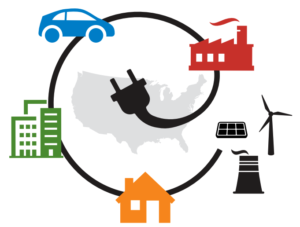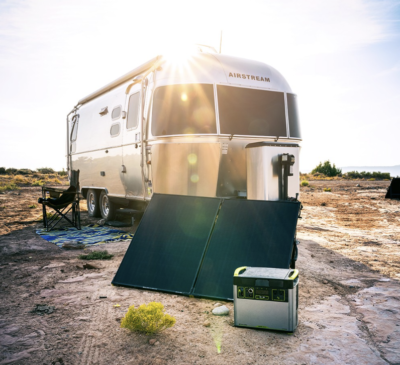Aggregated residential backup generators could help prevent brownouts
Editor’s note: The massive Texas power outages that took place in February 2021 left many people feeling insecure about reliable utility service. This is the fifth and final article in a series about the rapidly increasing number of backup power systems being installed in Austin area residences.

Bill Carter and his family live in the Austin suburb of Buda. Since he lived near a hospital, the electric circuit he was a part of rarely lost power during the February outage. “The biggest problems were mobility and frozen gasoline pumps. All of the grocery stores did not function for a week or so.”
But as a lifelong environmentalist and retired Texas Commission on Environmental Quality employee, he had been considering solar energy and more (electric-battery) self-reliance for some time. His wife has chronic health problems, and the family did not want to take a chance on power going out for any great length of time. The freeze became a motivational event but, in addition, electric outages in the Pedernales Electric Cooperative service area have sometimes lasted for 12 hours.
In July 2021, Carter installed more than 5 kilowatts (kW) of solar panels and a 21-kWh Enphase solar battery backup. While the new solar system will probably provide his home with more than 60 percent of its electricity over the course of the year, the expensive batteries will probably not yield a payback over their expected life. He made the investment for self-sufficiency. His home will have about half of an average day’s consumption stored, and more like two days if he’s careful after an outage. And that’s not taking into account the continued energy the photovoltaic array would be providing.
Looking back on the February outage, Carter said, “I think that the ERCOT (Electric Reliability Council of Texas) system is a travesty and definitely not protective of the electricity customers in Texas.” Conversely, he does not see his kind of grid independence as a long-term solution.
“ERCOT should not be a stand-alone grid” and should be interconnected to the rest of the country, he said. “I don’t think it’s a solution to ERCOT’s unreliability that people should go out and get generators.” He also said that public utilities (like Austin Energy) should have been allowed to keep all the power they generated during the outage to help their customers instead of being forced to feed it back to the larger dysfunctional ERCOT grid.
As the installation of standby generators proliferate, they will affect not only the electric system, but society as well. These effects will not be wholly negative or positive. This final part of this series on backup home generators will provide a nuanced view of a few of the major implications of this trend.
Demand side management
If the trend holds, and hundreds or thousands of backup generators are installed in Austin, it would be possible for Austin Energy to coordinate or aggregate them to offset peak demand. The utility, or contractor for the utility, could dispatch them in unison through WiFi to defer peak demand during a few critical hours of the year. The generator owners and aggregator contractors would, under this scenario, be compensated.
Load deferral through aggregation is hardly new. Austin Energy has paid financial incentives to reduce aggregated summer peak demand for decades. The utility already temporarily cycles off air conditioners during a few peak hours each year. In 2020, Austin Energy saved 102 MW of summer peak demand by deferring appliance loads from 102,000 customers. Another 70 MW of summer peak demand were saved by cycling industrial load.
If a thousand 22-kW standby generators had been operated by Austin homes served by natural gas (which have small winter electric loads) during Winter Storm Uri, they could have provided vital relief to as many as 17,000 Austin homes. Further, this power would not have been subject to ERCOT’s mandatory load-shed requirements that caused the blackouts.

I asked Roger Duncan, the former general manager of Austin Energy quoted at the beginning of the series, if he saw a potential in aggregating the load of several hundred residential generators that will be installed in the Austin area in the next year to defer the utility’s peak demand.
“Absolutely,” he said. “I support all versions of demand response strategies: virtual generators…microgrids…aggregation of generators.” When he worked for the City of Austin, he actually investigated aggregating emergency generators in large downtown buildings in the 1990s as an option to control peak demand, but at that time all the generators were diesel-fueled (with their inherent air pollution). “But today, if you have cleaner generators, demand response with them is quite valid.”
Generac backup generators come with aggregation ability preinstalled. Other units may require adapters, though adaptation costs are probably minimal.
Electrification
 Ardent clean energy advocates envision an energy system free from all fossil fuels, even inherently cleaner natural gas and propane. With greenhouse-associated weather catastrophes (including Winter Storm Uri) pointing toward a literally savage future, carbon hawks seek to replace carbon fuels with solar cells and wind. Among other strategies, they urge conversion of gas- and propane-heating for homes and businesses, as well as gasoline vehicles, to electrically powered alternatives.
Ardent clean energy advocates envision an energy system free from all fossil fuels, even inherently cleaner natural gas and propane. With greenhouse-associated weather catastrophes (including Winter Storm Uri) pointing toward a literally savage future, carbon hawks seek to replace carbon fuels with solar cells and wind. Among other strategies, they urge conversion of gas- and propane-heating for homes and businesses, as well as gasoline vehicles, to electrically powered alternatives.
With relatively scarce and still expensive energy storage to bolster intermittency, and other dispatchable renewable technologies (hydro and geothermal) absent or insufficient in various regions of the world (including Texas), this electrification strategy is not yet seamless. Further bedeviling the concept is a lack of public support.
Given the sheer number of people in Texas who survived Winter Storm Uri because of fireplaces and fossil fuel heating (or who fervently wished these had been available to them while shivering), it is going to be many years or even decades before many Texans are ready to consider universal electrification. For now, most consumers who can afford it are preparing for the next climate change-related weather catastrophe by installing standby generators fueled by natural gas or propane.
The rich can avoid unreliability

Residential electric customers wealthy enough to purchase standby generators are more likely to have reliable power in the event of another weather emergency. Those without the money may be in for more suffering. Just as there exists a digital divide between those who have access to broadband internet service, there will be an electric reliability divide between those with standby generators and those without.
There has always been a link between wealth and utility consumption, where people with more money consume more simply because they can afford more. As a rule, people with higher incomes have a higher level of consumption because they prefer and can afford the additional service for more comfortable homes, more space in these comfortable homes, and more water for greener lawns. Many utilities also levy regressive rates that reward high consumers with volume discounts. The more you use, the less you pay per unit. (Both Austin Energy and Austin Water have steeply progressive rates that reward customers who use less.)
However, reliability has seldom been in question. What we are seeing now is that people with means are paying for increased security of utility service, in many cases because they no longer trust grid reliability. And there are even tiers within this trend.
Those who can afford it and have the space can install larger, safer, standby generators that run on cleaner natural gas or propane to supply their whole home. Those with less money can buy portable generators. They are less convenient, noisier, and more polluting because they run on gasoline or diesel. Care must be taken to operate them safely. Portable generators also generally provide less electricity than standby generators. Cell phones, computers, lighting, and refrigerators may be powered with portable generators. Larger end uses such as central air conditioning and heat pumps, and resistance space- and water-heating will need more capacity.
Then there are people too poor to buy backup power, too frail to operate it, or do not own enough land to site it (usually in apartments). People in expensive downtown condos are an exception to this new model for attaining reliability. But if the condo residents chose, and the building has enough space, backup generators might be retrofitted. New condos can (and increasingly, probably will) have backup power installed during construction.

A relatively new appliance, the portable electric power station, will also be available to people who cannot afford standby generators. These relatively lightweight lithium battery packs (often weighing only between 8 to 40 pounds) can be placed indoors to power modest electric loads such as computers and table lamps. Larger units can also power refrigerators. They are charged from a wall-plug, though DC solar chargers are also often available.
While much cleaner than either standby or portable generators at the point of use, they have their limitations. Though smaller capacity units can be had for as little as $100 to $300, they are expensive considering the sometimes small amounts of power that they store. Larger units with solar assist can cost thousands of dollars. Even then, portable batteries will not allow enough electricity to provide heat or water heat to your home or the capacity to start and run a central air conditioner or heat pump.
Instead of freezing in the dark with these smaller units, you will still freeze while working on your computer in a dimly-lit home.
Conflicting motivation
I am an environmental activist, consumer advocate, and environmental writer. Since the late 1970s, I have been trying to advance solutions to eventually create an energy system that runs completely on clean energy, free of fossil and fissile fuels, in the real world. I have repeatedly come into conflict with some of my more idealistic colleagues when I have pointed out inconsistencies in their theories. You cannot legislate physics.
Some readers of this series of articles will no doubt conclude that I am extolling the virtues of natural gas and propane. Such judgment would be shallow.
Rather, I am reporting on a trend in energy use and in our society. One cannot change the future without acknowledging the present and learning from the past.
I may offer my regrets, but not apologies.
 Trust indicators: Paul Robbins is an environmental activist and consumer advocate who has lived in Austin for almost five decades. He is editor of the Austin Environmental Directory, a sourcebook of environmental issues, products, services, and organizations in Central Texas. The publication has been offered free to the public since 1995, and can be accessed free online.
Trust indicators: Paul Robbins is an environmental activist and consumer advocate who has lived in Austin for almost five decades. He is editor of the Austin Environmental Directory, a sourcebook of environmental issues, products, services, and organizations in Central Texas. The publication has been offered free to the public since 1995, and can be accessed free online.
I hope you enjoyed this series about residential generators. While the articles are free to the public, they took considerable time to craft. If you have the interest and ability to support this work, consider making an online contribution at: https://environmentaldirectory.info/.
(Disclosure: Bill Carter and Roger Duncan, who were interviewed for this article, are financial supporters of the Directory.)


Right – those who can afford the thousands of dollars required to buy/install home power units will revel in knowing how “smart” they were to take preventative action, and how Texas should NEVER join the national power grid. It is sad that the wealthy can act really stupid by supporting legislators who protect the power companies from doing what ought to be done. A lot more to be said here but our state is led by stupids who are crafty enough to support those who vote for their re-election.
‘“ERCOT should not be a stand-alone grid” and should be interconnected to the rest of the country, he said. ‘
This would not have helped much. OK, KS, and other areas in neighboring SW Power Pool also had similar outages, and they are connected. The ERCOT isolation is a red herring.
Dear WP,
The Southwest Power Pool has a misleading name. If you look at a map, you will see that it is largely made up of states in the Midwest.
According to the Energy Information Administration, there was substantial unused capacity in the Western U.S. during the time period of the outage.
That said, I appreciate you reading the article.
Author
I thought it was a well written and conservative minded article although written by “an environmental activist, consumer advocate, and environmental writer.”
I agree with Mr. Paul Robbins and as a consumer I can say his opinions are valid. Our elected ‘public servants’ and overpaid corporate overlords would be wise to listen to him.